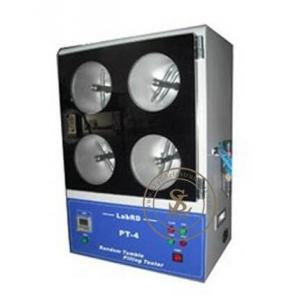SL - F03 D123 Tumble Pilling Tester , Random Pilling Tester ASTM Standards
Add to Cart
SL - F03 D123 Tumble Pilling Tester , Random Pilling Tester ASTM Standards
This test method covers the determination of resistance to the
formation of pills and other related surface changes on textile
fabrics. The method utilizes the Random Tumble Pilling Tester. The
procedure is generally applicable to all types of woven and knitted
apparel fabrics.
Note:- For other methods of testing the pilling resistance of
textiles, refer to the following ASTM methods: D3511 test for
Pilling Resistance and Other Related Surface Changes of Textile
Fabrics: Brush Pilling Tester Method. D3514 Test for Resistance of
Apparel Fabrics to Pilling (Elastomeric Pad Method) For directions
covering the measurement of resistance to pilling by the Appearance
Retention Tester, refer to Method D 1375 in the 1973 Annual Book of
ASTM Standards, Part 24. For direction covering the measurement of
resistance to pilling by the Inflated Diaphragm Tester and the
Reciprocating Table Tester, Refer to Method D 1375 in the 1966
Annual Book of ASTM Standards, Part 24.
2. Some fabrics that have been treated with a silicone resin cannot
be satisfactorily tested by this procedure because the silicone
resin appears to rub off on the cork liners in the test chamber and
to cause erroneously low results.
3. This standard may involve hazardous materials, operations, and equipment. This standard does not purport to address all of the safety problems associated with its use. It is the responsibility of who ever uses this standard to consult and establish appropriate safety and health practices and determine the applicability of regulatory limitations prior to use.
Referenced documents
ASTM Standards: D123 Terminology Relating to Textiles.
D1776 Practice for Conditioning Textiles for Testing.
F 104 Classification System for Nonmetallic Basket Materials.
Definitions
1. Fuzz : untangled fibre ends that protrude from the surface of a
yarn of fabric.
2. Pilling resistance : resistance to the formations pills on a
textile fabric.
3. Pills : Bunches or balls of tangled fibers that are held to the
surface of a fabric by one or more fibers.
4. For definitions of other textile terms used in this method, refer to Terminology D123.




